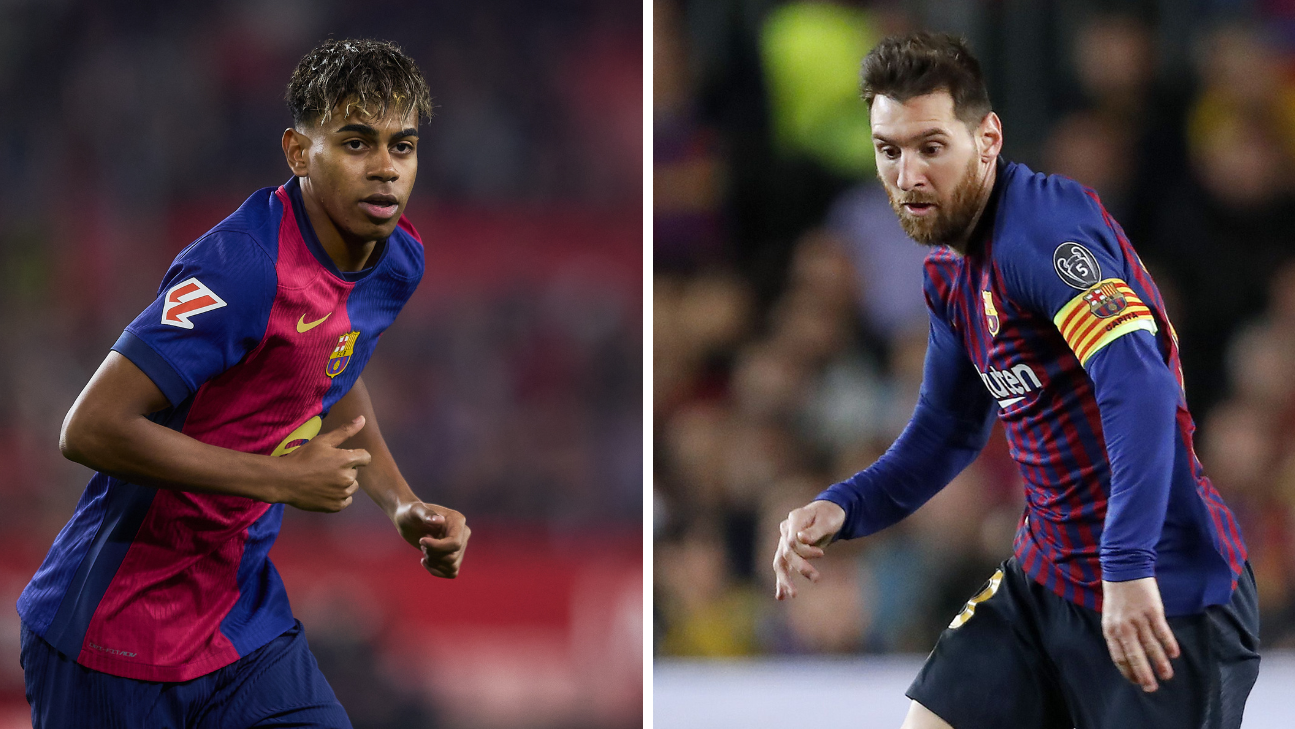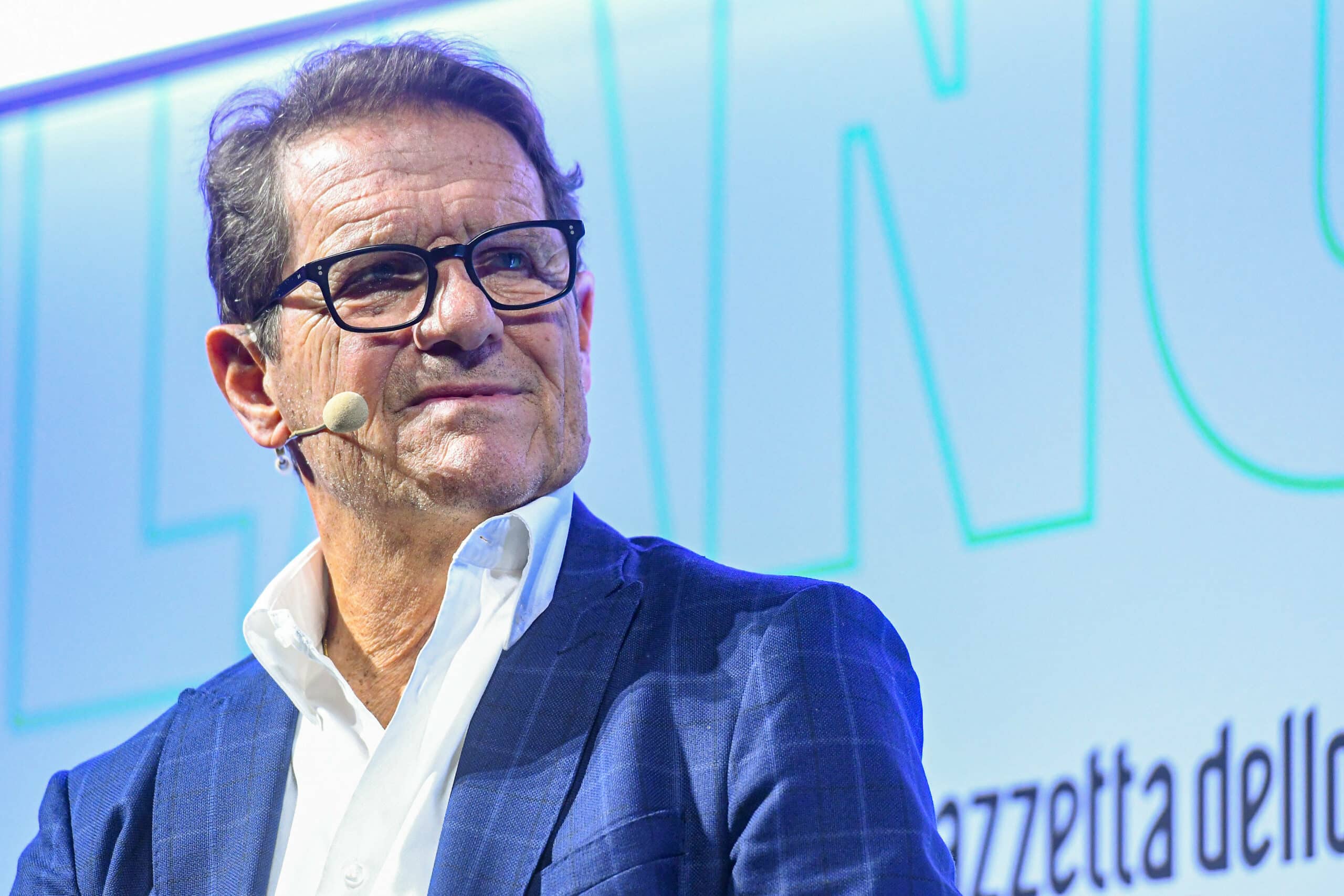Who says soccer can’t do player comps?
Well, no one. But we also rarely do it. Yes, there’s an entire Wikipedia page dedicated to the “New Diego Maradona.” But that’s really just a list of the best Argentine soccer players who were younger than Maradona. And so went the search for the next Lionel Messi. Pretty much every country has had their own Messi at this point; Canada, the United States, and Mexico have already had multiple Messis. These comparisons, of course, never went much further than “kind of short and very good at soccer.”
This is different from what we do with the major American sports. For the NFL and NBA drafts each year, player comps are the currency. At The Ringer, my former colleague Danny Kelly spins out classics every year for the NFL draft. This season, he has compared Boise State running back Ashton Jeanty to a “Battlebot Minotaur” and No. 1 overall prospect Travis Hunter to “Deion Sanders” even though Sanders’ own son is also in the draft. In the NBA, the website NBADraft.net once infamously compared Deshawn Stevenson, who went on to average 7.2 points per game as a pro, to Michael Jordan.
The beauty of these comps — when they’re not wide of the mark — is that they serve as a fertile shorthand. If you’ve watched football before, and I compare a prospect to Buffalo Bills quarterback Josh Allen, you immediately know he’s large, fast, borderline-reckless, and could throw a ball across the Great Wall of China.
Although soccer doesn’t have a draft — and although prospects are becoming relied-upon pros at increasingly younger ages — I think player comps can still be A) useful, and more importantly B) fun. So, I’ve pulled the top 10 most valuable under-21 players from the site Transfermarkt and come up with my own comps for each one.
Player comp: Lionel Messi, if he never needed growth hormones
It feels like this keeps happening, across all sports. Every time we say “We’ll never see another X,” we almost immediately … see another X. Roger Federer and Rafael Nadal were both supposed to be the best tennis players of all time — and then Novak Djokovic surpassed both of them. Even with the recent blowout loss to the Philadelphia Eagles, Patrick Mahomes is on pace to surpass Tom Brady’s records in the NFL. LeBron James’ career started just a couple months after Jordan’s ended.
I’m still taking the “under” on “Lamine Yamal is as good as Lionel Messi,” but man. Erling Haaland, Jude Bellingham, Kylian Mbappé, Vinícius Júnior — I hope you guys had fun! For me, Yamal already projects to have a better career than all of them. He was the best player on Spain‘s Euro 2024-winning team. He’s the best player on the No. 2 seed in the UEFA Champions League, Barcelona. And he’s 17 years old! As Mohamed Mohamed recently wrote for ESPN, he’s on track to be the best player in the world before he’s old enough to go to a nightclub in New Jersey.
Not only is he the best prospect since Messi; he’s a better prospect than Messi right now. In his age-17 season, Messi played 70 minutes for Barcelona and scored one goal. Yamal has five goals and 10 assists with 15 games left in his age-17 season. Oh, and he also started 22 games, scored five, and assisted five more in his AGE-SIXTEEN SEASON. Age-16 seasons are supposed to be spent in high school! Or with the under-17 team! Not starting and contributing at an above-average level for Barcelona.
In terms of playing style, young Messi was jittery and hyperactive. He was always smaller than everyone else, but he found a way to move at a staccato pace that no one had ever seen before. But at 5-foot-11, Yamal has the relaxed confidence of someone who has bullied the opposition at every age level.
In terms of how they impact the game, though, it’s not all that different. Yamal is the center of Barcelona’s solar system, despite playing on the right wing. He’s already an elite outlet, ball-carrier and goal-creator. To match Messi (what a ridiculous succession of three words), he’ll need to start scoring more goals and pulling more strings. But he has no issue getting into the box; he’s a fantastic ball-striker, and the passing skill and vision is clearly already there. He projects to develop all of that, too.
His prime, after all, doesn’t start for another seven years.
Jude Bellingham, 21, attacking midfielder, Real Madrid
Player comp: A bigger, faster, stronger, better Frank Lampard
It feels kind of silly to do a comp for a player who already moved to Real Madrid for €103 million, already won the Champions League, and already finished third in Ballon d’Or voting. But when Bellingham left Dortmund, I wrote the following:
Is he a Kevin De Bruyne-type: a “midfielder” who does all the things that a No. 10 did in the past but just from a slightly different starting position? Is he more along the lines of his idol, Steven Gerrard: a havoc-wrecker whose impressive physical range is best employed with other midfielders who cover all the spaces he leaves behind?
Is he more from the Marco Verratti, Thiago, and Joshua Kimmich mold: a modern midfield cheat code who wins the ball at a world-class rate but also contributes as much as anyone in possession, too? Or can he sit in front of the back four and bring some sudden solidity and strength to a midfield that previously fell apart whenever it lost the ball a la, say, Casemiro?
The promise of Bellingham is that he could be all of the above — at the same time.
Instead, he has basically become Lampard, if Lampard was a way better athlete. He can win the ball. He’s not uncomfortable if he has to drop deeper. He can carry the ball forward. He can play as a defensive winger(?), like he’s done recently for Madrid. But all of that stuff just allows him to be on the field so he can do the thing he’s best at: crashing into the penalty area and creating goals.
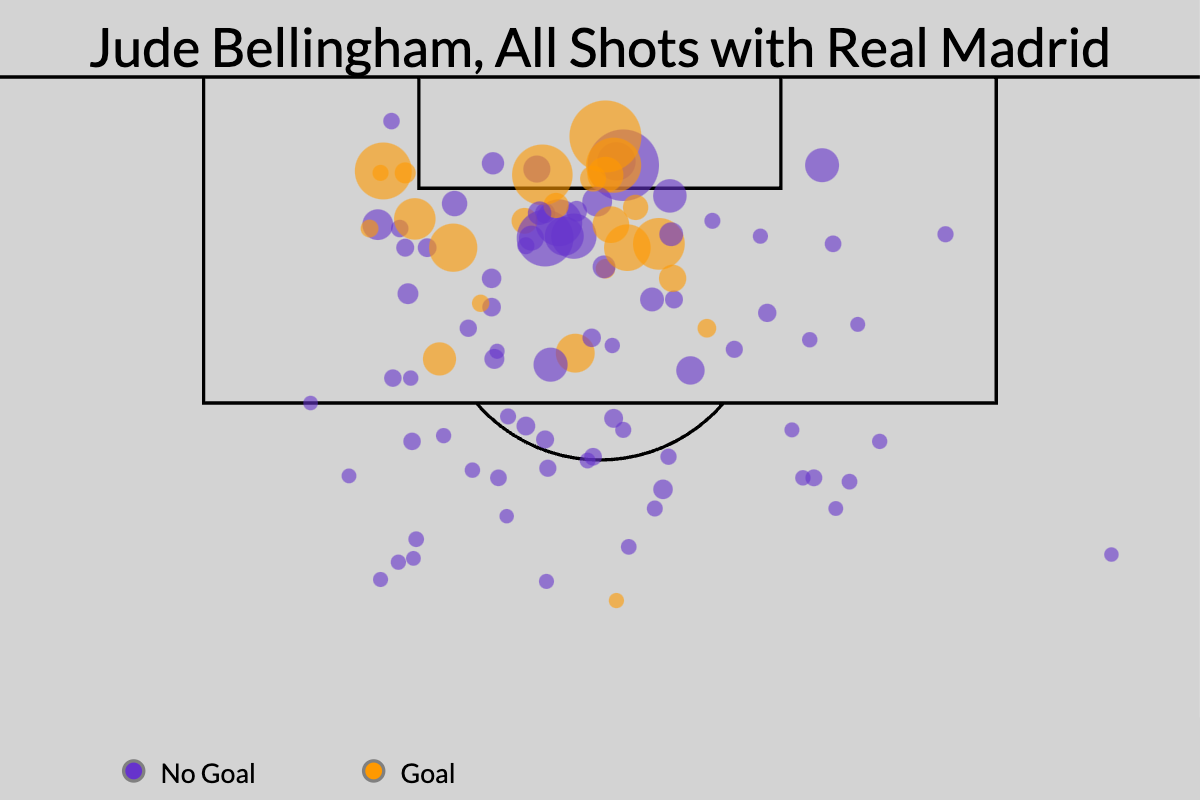
One of the reasons it was so hard for England to build a midfield with Lampard in it is because the other midfielders had to do a little more to cover for Lampard’s runs forward. Without Lampard running forward, he wasn’t Lampard. That’s not quite as true with Bellingham, but fitting him into the England midfield this past summer wasn’t as easy as it seemed like it should’ve been.
At club level, though, Chelsea‘s midfield always protected all of Lampard’s runs forward; Real Madrid obviously have the resources to do the same. For a 10-year stretch, Lampard had fewer than 15 goals and assists in just one season. While Bellingham’s finishing last season proved to be unsustainable — nearly eight goals above his expected total — it seems likely that he will go on a similar run, with a significantly higher baseline and better production at all of the non-goal-and-assist things, too.
Player comp: David Silva, with a mix of Kansas City Chiefs running back Isiah Pacheco
Silva is probably one of the most underrated players of the previous generation. He was overshadowed by the likes of De Bruyne at Manchester City, and the same was true with the Barcelona guys, Xabi Alonso, and even Cesc Fabregas for the Spain national team.
But he was basically a perfect attacking midfielder. On the ball, he was devastating. Off the ball, he was incredible. So, unlike some No. 10’s, you didn’t have to run your entire team through him to get all of his value. You could — and City often did — but Silva managed to function just as well alongside other creative geniuses because of how brilliant he was off the ball. In 2017-18 with City, he ranked in the 99th percentile for progressive passes received and progressive passes completed among all midfielders. That’s the whole ballgame.
With Leverkusen, Wirtz is 98th percentile for progressive passes and 90th for progressive passes received. He’s not as elegant as Silva — he’ll put his head down and run defenders over if he needs to — but he’s on a similar path toward top-level production. There are still some questions as to how he’ll translate to a more competitive league and to a team that’s not built around him. But he was great with Germany this past summer — playing for an elite-level coach in a team filled with other ball-dominant players.
Player comp: A tall Eden Hazard
Every generation, it seems like there’s one player who manages to pair absurd dribbling highlight reels with actual elite-level production. For the past decade, it was Hazard.
In American football, they say “low man wins” — the player who establishes the lower center of gravity tends to dominate any physical matchup. Well, Hazard’s center of gravity was somewhere in the middle of the Earth’s molten core. Jose Mourinho and Antonio Conte, two conservative, uber-demanding managers, essentially built their entire Chelsea teams around Hazard’s ability to carry the ball up field and then create chances all by himself. They could be defensive because Hazard was an entire attack unto himself.
In his ranking of the best young players in world soccer, Ali Elfakharany said that Musiala “is probably what Eden Hazard looks like in modern football if he was [6-1/2 feet tall].” Hazard wasn’t quite a goal-scoring winger like Mohamed Salah, nor was he a defend-and-attack cornerstone like Bukayo Saka. So, if he was just coming through today, he might be deployed more centrally like Musiala, whose insanely quick feet allow him to break apart opposition presses or deeper blocks.
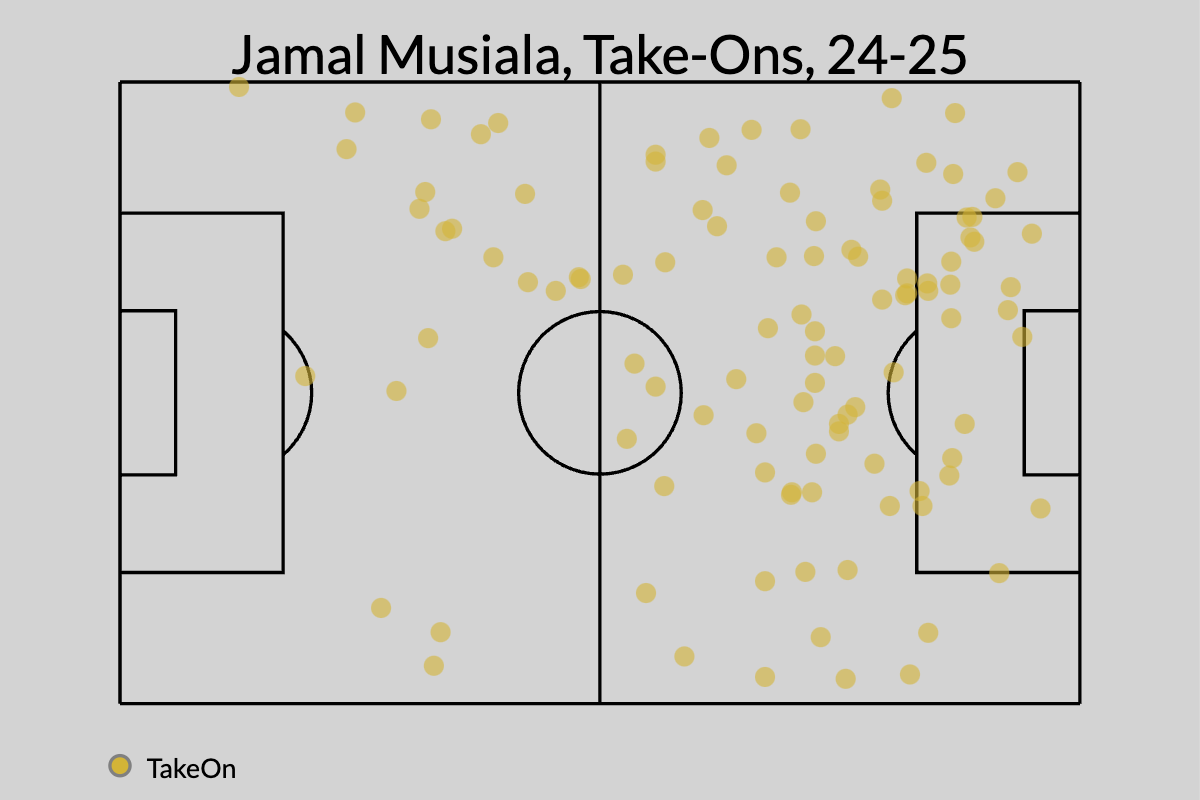
Playing for Bayern, Musiala does pretty much everything we can measure at an elite level: 90th percentile or above for expected goals, expected goals assisted, progressive passes, successful take-ons, and touches inside the penalty area. But it’s hard to know how much of that is the super-team effect, combined with the fact that he doesn’t play a ton of minutes. As Elfakharany pointed out, Musiala’s numbers in the Champions League are significantly behind his Bundesliga outputs, too. We haven’t seen him have to carry a team like the names before him on this list.
Musiala’s ceiling is Ballon d’Or winner. His floor, I think, is right around where Hazard ended up: an intermittently dominant superstar.
Gavi, 20, central midfielder, Barcelona
Player comp: Latter-career N’Golo Kanté, with a tiny bit of Nigel de Jong
It’s hard to project Gavi — both because he played an absurd number of minutes before his age-18 season and because he has really struggled with injuries over the past two years. These things, of course, are probably not unrelated!
But when a tiny, young midfielder bursts onto the scene at Barcelona, it’s easy to close your eyes and envision another Xavi or Andres Iniesta. Pedri, the other tiny, young midfielder at Barcelona is that. He’s already one of the best passers in the world. But at least at this point in his career, Gavi hasn’t been another one of these visionary tight-space masters. No, he’s been a maniacal presser who made great runs behind the opposition midfield and into the penalty area.
Although Kanté was a midfielder who was great at defense, he was not a traditional defensive midfielder. He didn’t screen the back line, like a class No. 6. No, he was at his best when he could run wherever he wanted, disrupting opposition play wherever it became vulnerable. In his last few years with Chelsea, too, he started to contribute a little more with the ball, as he was able to apply those off-ball defensive skills to the team’s attack.
I doubt Gavi will ever have the impact that Kanté did with Leicester City and early on with Chelsea; Kanté genuinely might have been the best player in the Premier League for two straight seasons. But as a tiny midfielder who still manages to impact the game without the ball, Kanté-shaped production — with a lot more instigating, ankle-biting, and ref-baiting — seems like Gavi’s path is to become a world-class player.
Leny Yoro, 19, center-back, Manchester United
Player comp: Joel Matip, if Joel Matip was a cat
Yoro remains the biggest projection on this list. He’s big, he’s tall, he’s fast and he doesn’t give the ball away. But we still haven’t seen him do anything with the ball at a consistently impactful level. And as a defender, he definitely sits on the “cat” side of the dog-cat dichotomy — meaning he fits best with a much more aggressive, go-and-get-the-ball center-back.
He’s still incredibly raw, and it’s been quite difficult to judge his performance at Manchester United. Of course, it’s difficult to judge everyone’s performance at Manchester United. But especially so for Yoro because he was hurt for much of the season, and then he got a new coach right as he healed up.
All that said, he has still played more minutes through his age-18 season than all but two six-foot-and-above center-backs in the FBref database: Kurt Zouma and Rio Ferdinand. Center-backs who play this much this early tend to end up being quite good.
So, what kind of “good” might he be? His body type — and what he showed in France — brings to mind a more subdued version of former Liverpool center-back Joel Matip — all limbs and risky runs forward with the ball. Matip was error-prone earlier in his career; that’s how Liverpool got him for cheap. But when he was healthy, he was one of the best center-backs in England.
Although we haven’t seen anything close to it yet, Yoro still has that potential.
Pau Cubarsí, 18, center-back, Barcelona
Player comp: Thiago Silva
At 6-feet tall, Thiago Silva was on the shorter side for a center-back, but he made up for it with positional genius and by being one of the best ball passers at his position that we’ve ever seen. Although he didn’t move to a big-five European league until he was 24, he still ended up playing 15 seasons at the highest level.
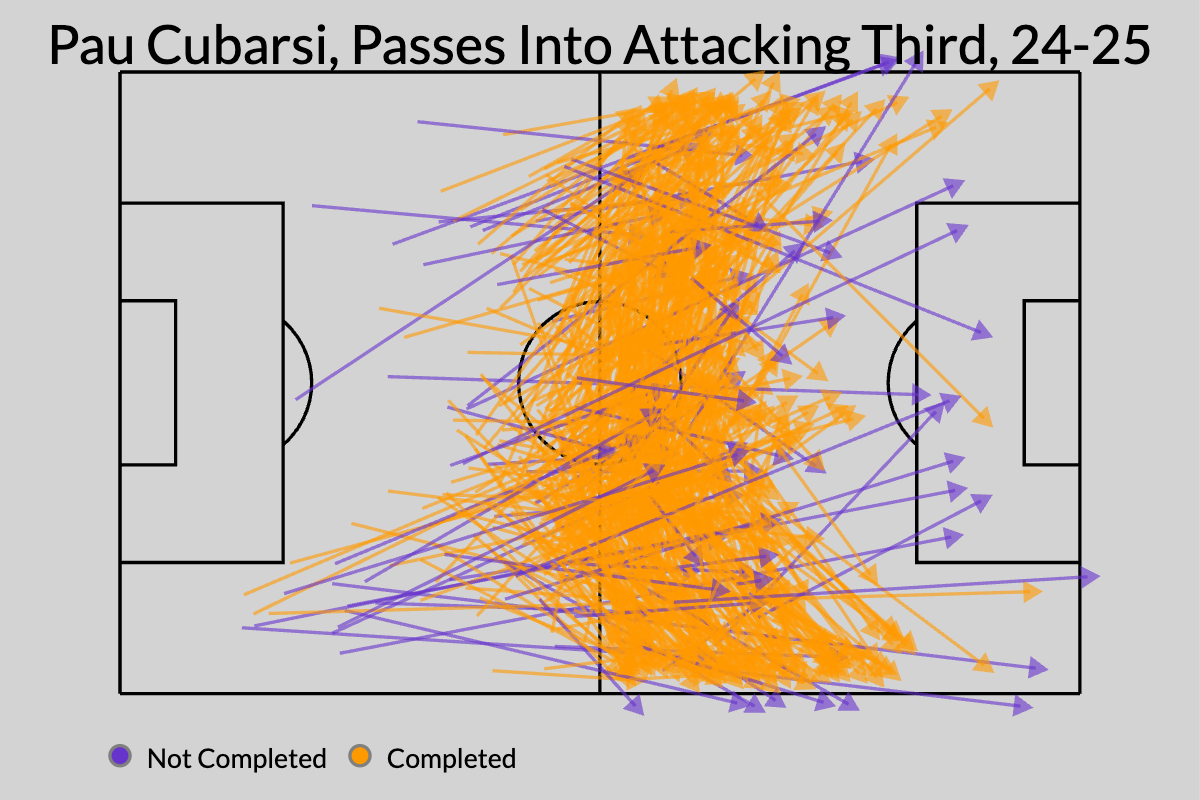
At 6-feet tall, Cubarsi is on the shorter side for center-backs, but he’s making up for it with intelligent positioning and already being one of the best ball passers at this position. He only turned 18 a month ago, and he’s in his second season as a starter for Barcelona, so he’s on track to play something like 15 seasons at the highest level.
Player comp: Juan Mata
Per the site FBref, Simons is 5-foot-6 and weighs less than 140 pounds. Last season, as a 20-year-old, he put up 19 goals+assists in the Bundesliga with Leipzig. Among all of the seasons for which FBref has data for, only one player who I’d classify as an attacking midfielder bested Simons’ production among the 21-and-under, 5-foot-6-and-under cohort: Mata and his 22 goal+assist season with Valencia in 2008-09.
I like Mata as a comp for Simons because they’re both as close to true No. 10s as you get. At least, they’re players who don’t really fit anywhere else. Neither has the speed to really take advantage of the open spaces on the winger. And they’re both too small to be relied upon as two-way midfielders.
Like Mata, who had two great seasons with Chelsea, then fell out of favor with Mourinho before joining Manchester United and getting pulled down by whatever ancient curse was activated when Sir Alex Ferguson retired, Simons’ career arc seems really dependent on him ending up in the right situation.
0:38
Why Xavi Simons’ move to RB Leipzig is a great deal for PSG
Julien Laurens believes Xavi Simons’s permanent deal with RB Leipzig will greatly benefit Paris Saint Germain moving forward.
Player comp: Esteban Cambiasso
Everyone talks about Claude Makélélé as the biggest collateral damage of Real Madrid’s Galactico era. With the club’s desire to acquire the most famous players in the world, they jettisoned their star defensive midfielder, a position that almost by definition prevents you from becoming a star. They won the league in 2002-03, signed David Beckham that summer, sent Makélélé to Chelsea … and then immediately finished fourth.
However, in 2002-03, a 21-year-old Cambiasso also started 18 matches in the midfield for Madrid at a time when young players rarely made an impact at that position. He, too, became a casualty of the Galactico era. Cambiasso started just four games after Beckham arrived and then left for Internazionale the following season.
At Inter, though, Cambiasso was one of the most consistent and underappreciated players in the world. He played 75% of the available league minutes over a full decade in Milan, for a team that won every trophy possible over his time with the club. Cambiasso was never really the prime ball-winner or ball-progressor at Inter; he just filled in the gaps for whatever the midfield needed at the time.
I think this is the kind of player that Zaire-Emery projects toward, too. And he’s basically that player already with PSG. João Neves is the do-everything ball-winner, while Vitinha and Fabián Ruiz get to do the flashy stuff with the ball. Zaire-Emery, like Cambiasso, gets to fill in all the gaps.
João Neves, 20, central midfielder, Paris Saint-Germain
Player comp: Mateo Kovacic
Kovacic’s career weirdly stalled out for a couple years at Real Madrid. But before moving to Spain, he was a darling of the early soccer data days. At Inter, he won the ball a ton and progressed the ball upfield, both with carries and line-breaking passes. The only two things he really lacked were size and long-range passing.
That’s pretty much exactly where Neves is right now, at roughly the same age that Kovacic was while he was with Inter. Ending up as the next Kovacic isn’t a bad outcome at all; that means you’re good enough to be a starter on a team that wins the Champions League. Neves might have a bit more upside, too. PSG manager Luis Enrique has played him as a full-back at times, which suggests a higher athletic range than Kovacic. And Neves could still develop a larger passing range, too.
The one thing he won’t develop, though, is more height. Barring a leg-lengthening procedure, he’s stuck at 5-foot-9.
